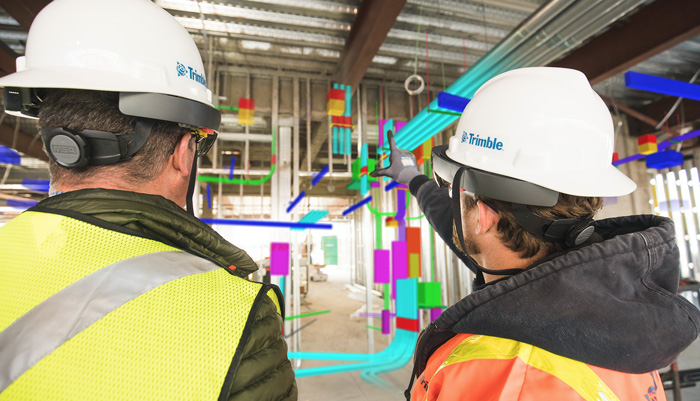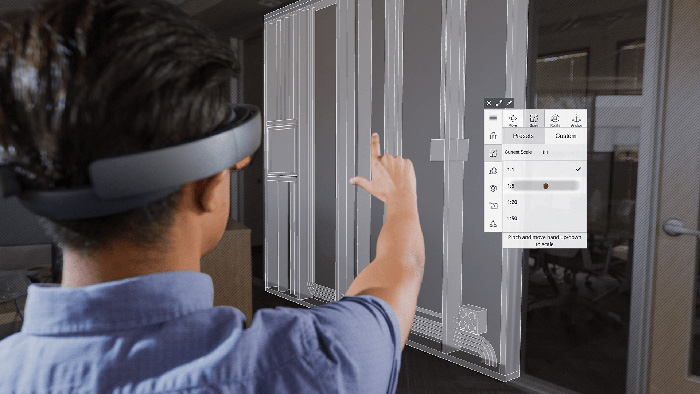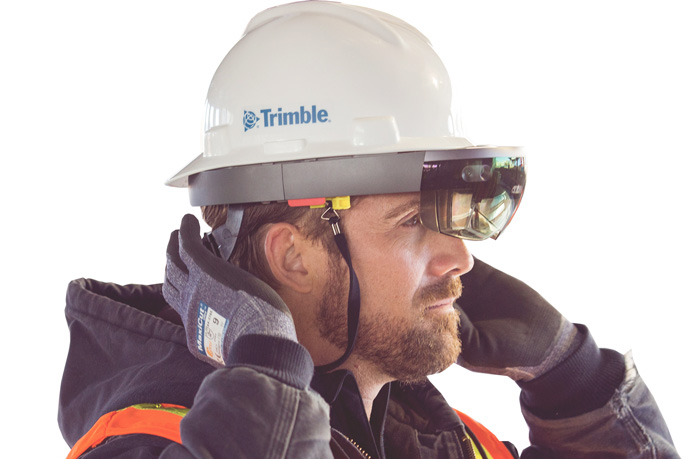The HoloLens 2 is a vast improvement over the first generation mixed reality headset. Visual experience and interaction might grab the headlines, but for AEC firms the biggest impact should come from Azure cloud connectivity
You’ve no doubt heard the name, but you might not know exactly what the Microsoft HoloLens does. In short, it’s a mixed reality headset that beams holographic images directly into your eyes. The visor is transparent so you can still see the real world around you, but it’s a world that is populated with virtual models that can be interacted with and manipulated as if they were real.
In the AEC sector there are two main use cases. The first is at 1:1 scale where 3D or 4D models can be seen on the construction site, in the precise location of where they will be built or where they should have been built. This could be to track progress, to help visualise or communicate construction sequences or for verification.
The second use case is for design review or project planning where multiple users collaborate around a scale model. This type of workflow is also common in fully immersive VR. But while VR offers superior visual quality, HoloLens is better for team communication as you can still see your fellow collaborators — expressions, gesticulations, and other non-verbal cues. Collaborative sessions can also be held across multiple locations.

In many respects the original HoloLens was a prototype unit. It was uncomfortable to wear for long periods, the viewing angle was poor, and it could only handle relatively small 3D models. Three years on and HoloLens 2 now addresses many of these issues.
The new HoloLens is easier to put on and while it is only slightly lighter, it is much more comfortable, having been re-balanced so it’s not so front heavy. I hardly noticed I was wearing the device throughout a ten-minute demo of Synchro XR, a special version of the virtual construction and 4D modelling tool from Bentley Systems. It’s also easier to jump in and out of mixed reality by flipping up the visor, rather than having to take off the device completely, as you did with HoloLens 1.
Field of view, the window through which you see the holographic images, has also been improved. With HoloLens 1 you had to be very precise about where you were looking, and it was easy for models to disappear out of sight. This also made it hard to see the wider context of a scale model as the edges simply got cut off. It was usable but it took some getting used to and you had to make some compromises in how your worked.

With HoloLens 2, Microsoft has increased the viewing area by 2.4x, and it’s both wider and higher. You still need to move your head precisely to bring models into view, but it does make the device more usable. The quality of the holographic images is also better; models are notably crisper and more vibrant.
These are all evolutions, but the way in which you interact with the device has changed quite dramatically. Forget the head gaze and finger tap. With natural hand tracking you now get 25 points of articulation per hand, for pinching, pulling and pressing. In Synchro XR, you can reach out and push 3D buttons that light up as your finger gets close, pinch and move sliders or grab, rotate and scale models as you would a real-world object. It’s not perfect — buttons sometimes failed to press first time during my 10 minute demo — but it’s much more intuitive than before.
Get yourself connected
All of the above advancements are important and lead to a much better experience, but the ability to connect HoloLens 2 directly to Microsoft’s Azure cloud service is likely to have the biggest impact on AEC workflows. On a general level, devices can be managed centrally, and users authenticated using Windows Hello technology. It also means everyone can access the very latest data, on demand, leading to much better clarity on projects.
There’s also no need to mess about with files. With the new Synchro cloud services, for example, 4D construction data is held in a cloud database that can be updated continuously through different devices – desktop, iPad or HoloLens.
With Synchro XR, users can experience a 1:1 scale, animated simulation of planned work in the context of where it will take place. Users can track progress, comparing recently completed work directly with the model. Updates can be done in real time and time stamped, as Greg Demchak, technical architect, Bentley Systems, explains, “If I change the status of some equipment or a piece of steel being erected, that becomes a moment captured in that database history and then because Synchro is time oriented we can scroll backwards through time. And you can see the playback of what happened.”
Synchro XR can also use the HoloLens to record voice notes which are then automatically turned into text and added to the model. The software doesn’t currently support video or photo notes but Demchak says this would be easy to do.
Cloud connectivity also means HoloLens 2 can handle significantly larger models. With HoloLens 1 you were limited to what the device’s onboard GPU could render, which is about 200,000 to 300,000 polygons at 60 FPS. This meant it simply wasn’t possible to work with a large construction model at a high level of detail. Instead, it had to be simplified or broken down into manageable chunks. HoloLens 2 blows this out of the water and it can now handle hundreds of millions of polygons. Rather than having to rely on the on-board GPU for graphics processing, the graphics can be processed remotely and streamed over WiFi.
Bentley is making the most of the new GPU streaming technology. Demchak told AEC Magazine that his team has streamed huge 600 million polygon models at 60 frames a second using Synchro. This has been done both with a local workstation and in the cloud using Microsoft’s Azure remote rendering service. Currently in preview, remote rendering can also be used with other devices including mobile phones and tablets. Of course, you’ll need a high-bandwidth, low latency connection to do this, and the roll out of 5G will help in the future.
Team effort Synchro XR is not just for on-site work. 4D models and animations can be explored from a bird’s eye view from the comfort of the office. Multiple participants can collaborate around the same model to get a better understanding of the work and project schedule.
Participants can grab the model, move it, rotate it, scale it up or down and take live sections. Using a time slider, it’s easy to step forwards and backwards through each stage in the construction sequence.
The beauty of the system is that everything feels really intuitive and much more natural than when interacting with models using the HoloLens 1. Bentley says virtually no training is required and I’d have to agree. With this in mind, the developers of Synchro are bringing processes into the HoloLens environment that historically needed to be done on the desktop application and hence required some degree of training.
Identifying and recording potential health and safety risks is a prime example. Here, 3D icons representing ‘fall risk’, ‘electrical hazard’ and others can be dragged and dropped into the model. The plan is to introduce more functionality which could include logistics planning, where users can place things like tower cranes, diggers, scaffolding and temporary works at different stages along the timeline.

Going the distance?
In 2016, weeks after Bentley got hold of its first HoloLens 1, Bentley fellow Stéphane Côté could hardly contain his excitement when he told AEC Magazine that it offered ‘truly exceptional tracking for indoor applications’.
This might be true over short distances but from our discussions with AEC firms over the last few years it would seem that accuracy over longer distances is not as good. Objects might appear in the wrong location, offset from where they should be.
HoloLens 2 doesn’t solve this, admits Mark Day, global sales lead, mixed reality, Microsoft, but it’s far more accurate than HoloLens 1, “So instead of being able to look at two metres and be five centimetres off, we might only be five centimetres or ten centimetres off at twenty metres. But you’re still off and your ‘off’ isn’t necessarily going to get bigger in relationship the further you go out.”
Bentley has been exploring the use of spatial anchors that the HoloLens 2 would pick up as you move through the building and adjust. “You want to use more terrestrial and celestial data input to be more geospatially accurate,” adds Day.
Here comes the sun
There are other limitations. It’s been widely reported that HoloLens doesn’t work well in direct sunlight and this remains the case for HoloLens 2. Construction firms are finding workarounds though.
Demchak recalls a customer that carries an umbrella and another that literally covers the whole visor to go into a ‘temporary VR mode’. Trimble has developed a hard hat version of the HoloLens 2, the XR10, through Microsoft’s OEM program. Maybe someone will find a practical solution to combat direct sunlight. Until then HoloLens 2 is likely to find more favour with interior construction projects or retrofits, rather than on open sites.
Conclusion
HoloLens 2 feels like a significant step forward for Microsoft and its mixed reality device. While HoloLens 1 felt a bit like a development platform, HoloLens 2 looks ready for market. The enhanced viewing area and better interaction are certainly welcome improvements but it’s the Azure cloud connection that really turns this into an enterprise ready device. Whereas previously firms may have struggled with file-based transfer; now with applications like Synchro XR the data can flow much more freely. We’re looking forward to hearing how construction firms get on.
If you enjoyed this article, subscribe to our email newsletter or print / PDF magazine for FREE






